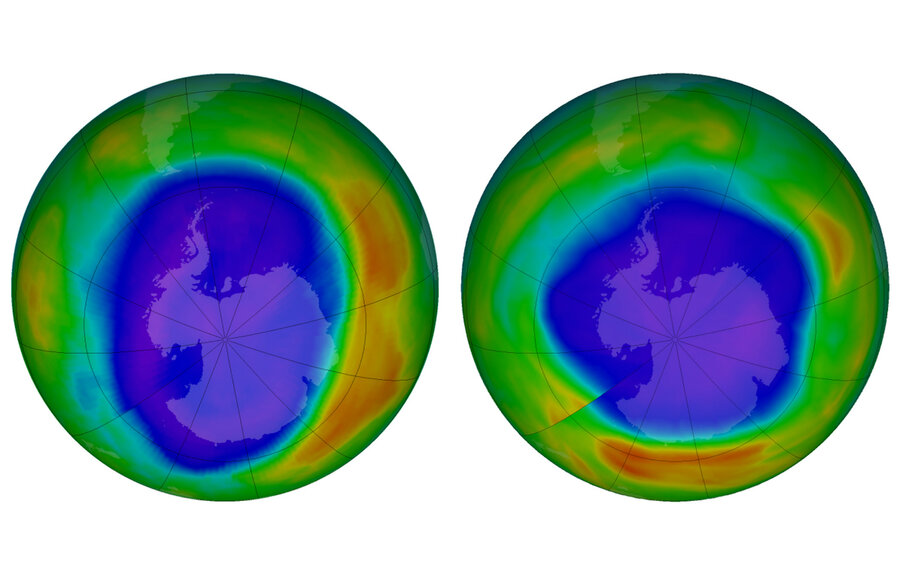In the clouds, a silver lining: The ozone layer is on track to fully heal
Loading...
There is a silver lining to the ominous hole in Earth’s vitally protective ozone layer, observed over Antarctica since the late 1970s. It’s not only showing signs of healing, it’s on track to fully close by midcentury. Concern over the expanding hole in the protective layer launched the Montreal Protocol in 1987, with 197 countries signing on to phase out the production of industrial chemicals that can trigger the breakdown of ozone. Scientists credit the protocol for the healing first reported above Antarctica in 2016 and, according to an executive summary recently released by the United Nations, expect the stratosphere to be fully restored by 2060. Researchers are calling the ozone’s shrinking hole slow but steady progress. “We sit on the ground and watch and wait like paint drying for this to happen, but ... it is drying,” says David Fahey, director of the Chemical Sciences Division at the National Oceanic and Atmospheric Administration’s Earth System Research Laboratory. Scientists hope that the success of the Montreal Protocol will encourage policymakers to embrace other international diplomacy projects addressing climate change. “We like to talk about it as giving encouragement to take on the harder problem,” says Fahey.
Why We Wrote This
While projections of climate change consequences are dire, the international community has shown it can cooperate to achieve results on ecological issues, as seen in the reduction of the hole in the ozone layer.
There is a silver lining to the ominous hole in Earth’s vitally protective ozone layer, observed over Antarctica since the late 1970s: It’s not only showing signs of healing, it’s on track to fully close by midcentury.
Closer to Earth’s surface, ozone is a pollutant and the main ingredient of smog. But six miles up in the stratosphere, or ozone layer, it shields the planet from harmful solar radiation.
Concern over the expanding hole in the protective layer launched the Montreal Protocol in 1987, with 197 countries signing on to phase out the production of industrial chemicals that can trigger the breakdown of ozone.
Why We Wrote This
While projections of climate change consequences are dire, the international community has shown it can cooperate to achieve results on ecological issues, as seen in the reduction of the hole in the ozone layer.
Scientists credit the protocol for the healing first reported above Antarctica in 2016 and, according to an executive summary recently released by the United Nations, expect the stratosphere to be fully restored by 2060.
Researchers are calling the ozone’s shrinking hole slow but steady progress.
“The rates of those processes are sufficiently slow,” says David Fahey, director of the Chemical Sciences Division at the National Oceanic and Atmospheric Administration’s Earth System Research Laboratory and a lead author on the study. “We sit on the ground and watch and wait like paint drying for this to happen, but ... it is drying.”
Healing the ozone layer first takes preventing those harmful chemicals from getting into the stratosphere – that’s what the Montreal Protocol was about. It targeted chlorofluorocarbons (CFCs), chemical compounds that were commonly used as refrigerants or propellants. The chlorine in the compounds can trigger chemical reactions in the stratosphere that break down ozone.
But, Mr. Fahey explains, “These ozone-depleting substances ... take a very long time to get out of the atmosphere.” Even when culprits like aerosol cans have been fully phased out of production, their effects on the ozone can linger for years.
In the lower layers of Earth’s atmosphere, there are already strong signs of progress: In 2016, chlorine levels in the troposphere (the lower boundary of the stratosphere) were 11 percent lower than at their peak in 1993. But ozone layer chlorine levels aren’t expected to return to the levels of 1980 until the 2040s. And in some parts of the ozone layer, the damage is so severe that it could take as many as two more decades to fully heal.
Even with global efforts, scientists are concerned that the amount of CFCs in the atmosphere isn’t decreasing as quickly as expected. The slowdown is largely attributed to increasing emissions of CFC-11 – most likely in East Asia, according to a May report published in the journal Nature. (All 197 signers of the Montreal Protocol agreed to stop producing and emitting CFC-11 by 2010.)
“[Policymakers] are considering all those things quite carefully,” says Stephen Montzka, a coordinating lead author of the UN executive summary and lead author of the Nature report. “So we’ll have ramifications. I don’t know what they’ll be at the moment, especially since no particular country has been actually identified as the sole source or the main source.”
Additionally, a December study published in Nature Geoscience found that emissions of chloroform could also delay ozone healing. Chloroform emissions, which are not regulated by the Montreal Protocol, could add another four to eight years to the recovery projections.
If CFC-11 emissions continue to increase, they could push the general healing of the ozone layer back seven years, and the healing of the hole over Antarctica back 20 years to 2080, according to the UN summary.
But steps are being taken to identify the worst offenders. And soon other ozone-depleting chemicals, hydrofluorocarbons (HFCs), will also be targeted. The Kigali Amendment to the Montreal Protocol, requiring nations to significantly decrease their production of HFCs, will go into effect for developed countries in 2019 and developing countries in 2024.
This change is expected to have the added benefit of helping to reduce global temperatures. And scientists hope that the success of the Montreal Protocol will encourage policymakers to embrace other international diplomacy projects addressing climate change.
“[The ozone layer] was an easy problem. Even as complicated and as difficult and time consuming as this was, climate is far more complex and demanding of the world,” Fahey said. “We like to talk about it as giving encouragement to take on the harder problem.”








